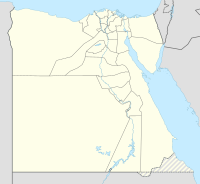Mortuary temple of Sesostris II.
| Mortuary temple of Sesostris II in hieroglyphics | |||||||||||||||||||||
|---|---|---|---|---|---|---|---|---|---|---|---|---|---|---|---|---|---|---|---|---|---|
| During the lifetime of Sesostris II. |
(Sechem-S-en-Wosret) Sḫm-Sn-Wsrt Sesostris is powerful |
||||||||||||||||||||
| After his death |
Sḫm-Sn-Wsrt-m3ˁ-ḫrw Sesostris is mighty and justified |
||||||||||||||||||||
The mortuary temple of Sesostris II. ( Sechem-Sesostris ) is located in the pyramid complex of the Sesostris-II.-pyramid not far from al-Lahun , whereby the name Sechem-Sesostris referred to the valley temple and the adjacent district of al-Lahun. After his death, the name of the mortuary temple was extended to “ Sechem-Sesostrismaa -cheru ”.
The route to the Sesostris II pyramid has not yet been explored. The location of the mortuary temple in the valley is known, but not its layout. The temple was probably completely demolished by stone robbery in ancient times. The discoverer Flinders Petrie called the place al-Lahun "Kahun", but this name is based on a hearing error of Petries who understood "Kahun". In more recent research, the name al-Lahun has therefore established itself for this region.
Papyri finds
Numerous papyri were found under the name “Kahun” , which is why the contents published by Ludwig Borchardt and Flinders Petrie, for example , are also called Kahun papyri . Today the name Lahunpapyri is gaining ground.
Temple festivals
In their character as temple diaries, the Lahunpapyri from the temple archives name the festivals Sothis , Chenep-sha and Menchet as the most important celebrations , as well as the daily rations that the temple staff received. The records show that daily 410 different kinds of bread and 172 Chenep - and 63 Setjakrüge for the same beers were in use. Most victim accounts do not contain any figures.
In the temple diary is also the Sothis date from the seventh year of the reign of Sesostris III. indicated for the 16th Peret IV , which was followed a day later on the 17th Peret IV by the Sothis festival. An additional delivery of "200 different breads and 60 mugs of beer" is noted for this day.
Temple furnishings and temple cult
From the Lahun Papyri it appears that the temple was furnished with large numbers of statues of the temple staff, for example two Tjati statues and one each of the head of the seal , the royal secretary and other senior officials. Other private statues are also known.
As with Sesostris I , a twofold cult is assumed. On the one hand, the deceased king was sacrificed, on the other hand, the temple staff and their relatives also received donations in the form of statues. In addition, further offerings to the ancestors of the royal family as well as to the deceased kings can be assumed.
Probably in the temple, but certainly in the area called Sechem-Sesostris, there were also temples or sanctuaries of Anubis and Sobek .
See also
literature
- Ludwig Borchardt: The second papyrus find from Kahun and the temporal determination of the middle realm of Egyptian history . In: Journal for Egyptian Language and Archeology (ZÄS) 37 . Leipzig 1899, pp. 89-103.
- Wolfgang Helck : Economic history of ancient Egypt in the 3rd and 2nd millennium BC (= Handbook of Oriental Studies . Department 1: The Near and Middle East. Volume 1: Egyptology. Section 5). Brill, Leiden et al. 1975, ISBN 90-04-04269-5 .
- Rolf Krauss : Sothis and moon dates. Studies on the astronomical and technical chronology of ancient Egypt (= Hildesheimer Egyptological contributions. Vol. 20). Gerstenberg, Hildesheim 1985, ISBN 3-8067-8086-X .
- Ulrich Luft: Hieratic papyri from the National Museums in Berlin - Prussian Cultural Heritage - Delivery 1: The Illahun Archives, Part 1: Letters . Academy, Berlin 1992, ISBN 3-05-001854-2
- Ulrich Luft: Documents on the chronology of the late 12th dynasty: Letters from Illahun . Publishing house of the Austrian Academy of Sciences, Vienna 2006, ISBN 3-7001-3300-6
- Richard-Anthony Parker: The calendars of ancient Egypt . Chicago Press, Chicago IL 1950.
- Siegfried Schott: Ancient Egyptian Festival Dates , Publishing House of the Academy of Sciences and Literature, Mainz / Wiesbaden 1950
Individual evidence
- ↑ a b Rainer Hannig: Large Concise Dictionary Egyptian-German: (2800 - 950 BC) . von Zabern, Mainz 2006, ISBN 3-8053-1771-9 , p. 1186.
- ↑ a b c Rolf Krauss: Sothis and moon data: studies on the astronomical and technical chronology of ancient Egypt . P. 85.
- ^ Z. Horváth, Temple (s) and Town of El-Lahun: A study of ancient toponyms in the el-Lahun papyri, in DP Silverman, WK Simpson, J. Wegner (editors), in Archaism and Innovation: Studies in the Culture of Middle Kingdom Egypt, New Haven, Philadelphia 2009, pp. 171-199, especially, p. 197
- ↑ Stephen Quirke : Gods in the temple of the king: Anubis at Lahun , in: S. Quirke (ed.) The Temple in Ancient Egypt, New Discoveries and recent research , London 1997, pp. 24-48
